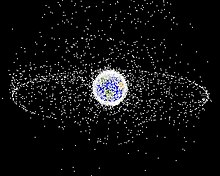
Back متلازمة كيسلر Arabic Síndrome de Kessler Catalan Kessler-Syndrom German Síndrome de Kessler Spanish Kessler sindrome Basque سندروم کسلر Persian Kesslerin syndrooma Finnish Syndrome de Kessler French Kessler-szindróma Hungarian Sindrom Kessler ID

The Kessler syndrome, also known as the Kessler effect,[1][2] collisional cascading, or ablation cascade, is a scenario proposed by NASA scientists Donald J. Kessler and Burton G. Cour-Palais in 1978. It describes a situation in which the density of objects in low Earth orbit (LEO) becomes so high due to space pollution that collisions between these objects cascade, exponentially increasing the amount of space debris over time.[3] This proliferation of debris poses significant risks to satellites, space missions, and the International Space Station, potentially rendering certain orbital regions unusable and threatening the sustainability of space activities for many generations.[3] In 2009, Kessler wrote that modeling results indicated the debris environment had already become unstable, meaning that efforts to achieve a growth-free small debris environment by eliminating past debris sources would likely fail because fragments from future collisions would accumulate faster than atmospheric drag could remove them.[4] The Kessler syndrome underscores the critical need for effective space traffic management and collision avoidance strategies to ensure the long-term viability of space exploration and utilization.
- ^ Stenger, Richard (2002-05-03). "Scientist: Space weapons pose debris threat". CNN.com. Archived from the original on 2012-09-30. Retrieved 2011-03-17.
- ^ Olson, Steve (July 1998). "The Danger of Space Junk – 98.07". The Atlantic. Retrieved 2020-06-18 – via TheAtlantic.com.
- ^ a b Kessler, Donald J.; Cour-Palais, Burton G. (1978). "Collision Frequency of Artificial Satellites: The Creation of a Debris Belt" (PDF). Journal of Geophysical Research. 83 (A6): 2637–2646. Bibcode:1978JGR....83.2637K. doi:10.1029/JA083iA06p02637. Archived from the original (PDF) on 2011-05-15.
- ^ Cite error: The named reference
k09was invoked but never defined (see the help page).